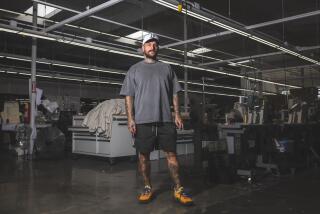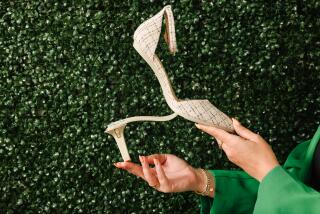Sticking with it
The climber’s knuckles are white, his fingers act as claws groping a thin crack in a tan rock face. He glances down at an edge no wider than a nickel and thrusts his left foot toward it. He misses and tumbles off.
But the misstep at Mt. Rubidoux in Riverside isn’t high drama.
“I’m old, fat and out of shape,” Charles Cole chuckles after his foot-high tumble. “But this is a very good rubber.”
Rubber so good that Cole, the man behind the soles, won’t reveal where the sticky stuff is made. He even gave the rubber a super-secret name -- Stealth -- which is today the major brand for his company, Five Ten, which sells more climbing shoes than any other company in the world.
Since starting his business in 1985, Cole’s soles have redefined climbing shoes among amateurs and hard-core big-wall types -- and transformed him from a climber eating strangers’ leftovers to the Bill Gates of footwear for the vertically inclined. It’s a ropes-to-riches story that had an unpredictable start.
“The European companies making climbing shoes had Cole absolutely skunked on shoe design and craftsmanship,” says Daniel Duane, a climber, resoler and author of “El Capitan: Historic Feats and Radical Routes.” “The only thing Cole had going for him was rubber. But it’s a neat story, this American guy in his backyard or garage or whatever, boiling rubbers in a big vat and trying this and that, and coming up with this stuff that was light-years ahead of what the Europeans had.”
After his climb and short tumble, Cole, 50, hops into his red Hummer for the half-hour drive back to Five Ten’s headquarters in Redlands. It’s a route that he’s been following for the last 15 years, developing and testing combinations of polymers on the granite of the Inland Empire.
Cole’s office is small and windowless. The desk is cluttered with a dozen Dr Pepper cans, various tools, rubber samples. On the walls are blackboards chalked with formulas and notes, and there are photographs: Five Ten’s first digs, Cole’s family and climbing goddess Lynn Hill, a rose in her teeth, standing beside Cole, a tree branch in his. There’s a case containing a piton made from a Model A axle by John Salathe, a climbing pioneer who was the first person to forge a piton out of steel. Cole plucked it from Lost Arrow Chimney, a wicked route beside Yosemite Falls. It’s his favorite possession.
Cole’s rubber hit the market at a time when climbing gyms were becoming the urban rage. Although the construction of his shoe was imperfect, it was the rubber that soon made the difference, earning Cole the respect of such climbers as Hill, Ron Kauk and Jimmy Dunn.
Kauk is too proud to credit technology for climbing feats -- like his first ascent in 1996 of a 5.14 crack climb dubbed Magic Line near Yosemite’s Vernal Falls -- but he admits that a pair of Five Tens helped him create the route.
“I had been falling off,” he says, each fall cut short by anchored rope. But after putting on a pair of Five Tens, he completed the climb. As great as the stickiness is, he says, the rubber gave him a psychological edge.
Todd Skinner, one of the premier U.S. climbers during the ‘90s, says it’s common for climbers sponsored by La Sportiva and other Five Ten rivals to have their brands’ shoes resoled with Stealth rubber -- or climb with Five Tens when outside of the camera’s eye.
Into the laboratory
Cole’s lab is a few strides from his office. Here, amid mixers, mills and other machines, Cole transforms his formulas into black rubber disks -- samples he’ll then put through a battery of tests. On the other side of the wall, 20 Five Ten employees field customer calls and tend to the business side of the company, whose annual income is in the low eight digits.
Cole has come a long way from his days as an undergraduate at USC when he and his buddy Bob Hass saw “The Eiger Sanction,” an action thriller set on the Swiss peak, and decided to give rock climbing a try.
“After that, we climbed every weekend through graduation, then went to Yosemite,” Hass recalls.
In the valley, Cole succumbed to the life of a climbing bum, eating meals Japanese tourists left behind and making a few bucks by helping with rescues and selling climbing photos to Patagonia.
On one wall of his office are reminders of those days: the map routes of El Capitan and Half Dome, which show three of his first ascents.
By 1979, Cole started feeling guilty about “doing nothing but climbing” and sought out a business school far from any distracting rocks. He received a master’s in business from the University of Michigan two years later -- and immediately returned to Yosemite.
Cole’s life took a turn in 1985 when his father suffered a stroke. He needed to get a job, and since all he knew was climbing, he decided to try manufacturing climbing products. He called his fledgling company after 5.10 -- a rating that connoted difficult climbing routes.
Mom handled the books, Dad answered the phone, and Cole met with rubber salesmen and an agent for a Taiwanese shoemaker. Soon 1,000 pairs of what would now be called approach shoes -- those worn to the base of a climb -- bearing the Five Ten logo reached the United States.
But they were a disaster. The leather fell to pieces. By comparison, the soles were more durable and particularly soft and gummy -- “sticky,” in climbing parlance.
As a result, some rock climbers took to cutting the soles off Five Tens and gluing them on their rock-climbing shoes.
That gave Cole an idea. He read every library book on rubber at Caltech and began working with a chemist, telling him what to add to the base polymer. In ‘87, he debuted the first of several sticky rubbers bearing the Stealth name.
Today Cole spends most of his working hours in the lab, adding curatives, accelerators, carbon blacks and plasticizers to blobs of clear polymers and testing rubber samples he’s made for tensile strength, friction, cure rate, hardness, abrasion -- everything except their ability to adhere to a narrow ledge.
There’s only one way to test how shoes will perform on tiny ledges, and it can’t be done in the lab or by a machine. Which is why Cole drives to Mt. Rubidoux and a near-vertical slab he’s been on hundreds of times since he first tried it 28 years ago.
On this day, he put on a pair of Altia’s, Five Ten’s high-top climbing shoe, which isn’t yet on the market.
“The rubber either gets you up the climb or it doesn’t,” Cole says as he makes five successful traverses on a steep slope before tiring out and thrusting his foot too low to catch an edge. “The rubber is the last word.”
In the no-fall zone
To appreciate how innovative Stealth rubber has been, you have to know what preceded it. Climber Dunn recalls scaling Whitehorse Ledge in New Hampshire, a smooth, low-angle climb like Yosemite’s Glacier Point Apron. It was the early 1970s, and he wore a pair of RD Varrapes, the best climbing shoes at the time.
“It felt like I was on blocks of wood,” Dunn says. All that changed when Cole’s rubber became available. “With Stealth rubber, you could do the same thing but instead of feeling like you’re going to fall off every second you could go up with no hands. It’s just sticky. Just really sticky.”
Sales of Stealth rubber and Five Ten climbing shoes shot from $125,000 in 1986 to $1.2 million in 1989, according to Cole. His staff began to include people other than family members, and he moved the business from North Hollywood into a new industrial park in Redlands.
About 75% of Five Ten’s business is rock climbing shoes, nearly all of which are made in Placentia (though Cole won’t divulge where the rubber is made). The rest of the company’s footwear -- including watersport, mountain biking and trail running shoes -- is assembled in Asia.
Among his current projects are mountain-bike tires that rely on spongy studs for cushioning and grip, and a liquid version of the rubber that could be silk-screened onto gloves for the construction workers who carry cinder blocks and other heavy objects.
He is even developing a product for the Defense Department.
“That all I’m working on?” he asks jokingly. “I can only do so much so quickly.”
*
Scott Doggett can be reached at scott.doggett@latimes.com.
More to Read
Sign up for The Wild
We’ll help you find the best places to hike, bike and run, as well as the perfect silent spots for meditation and yoga.
You may occasionally receive promotional content from the Los Angeles Times.






